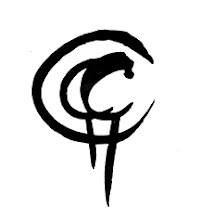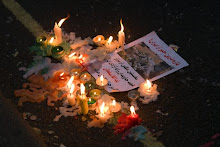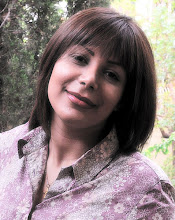




Neda Agha Soltani: About A Picture
‘Oh, that’s the girl that was shot isn’t it?’ Asks the policeman.
Earlier the same day my sister had asked the same question when she saw my banner peeping out of my bag with the unmistakeable face of Neda Agha Soltani, her head tilted slightly to one side, loose hair and a bright, unaffected smile.
‘Why Neda? I mean why her in particular?’ Asks my niece.
‘She’s very pretty,’ comments my sister, suggesting this might be why her death was singled out among so many. She is, but I can say with confidence that this is not the reason.
The death of Neda was intensely shocking because it happened in public, in daylight, at short range and was witnessed live in real time by hundreds and, having been captured on camera, by millions.
A Picture Outside Its Context
There are other qualities and details about the picture above, however, which suggest that her face will forever be associated with the Iranian resistance as it emerged in response to the coup d’etat (‘election’) on June 12th 2009. If you google, ‘Neda Agha Soltani’ and press the ‘images’ key, you will find hundreds, perhaps thousands of blogs which include this image. Studying these began to raise questions in my mind about the delicate balance of mourning, of expressing overwhelming sorrow and how easily that can tilt just too far and become a kind of exploitation or fetishisation. It’s hard to imagine how this might feel to her family and friends. It may be uncomfortable or of no consequence at all to them. It is, ultimately, a photograph. It is not Neda.
On many of these blogs, this image has a red circle on it. If you look closely at the image, you will see, not quite concealed under the shirt, she is wearing a crucifix. It is this that is circled.
I don’t know if Neda was a Christian of not, and don’t consider it a matter of importance. That she wears a crucifix does not automatically indicate Christian faith or practice. However, this picture has been adopted by numerous Christian minority communities all over the Middle East, the Arab and North African regions and in the Far East. If the blogs are anything to go by, it is a matter of immense importance to them.
The second significant point is that in this photograph, Neda in not wearing hejab. At a single stroke, this renders this image more understandable and more sympathetic to non Muslims. Put simply, she could be the girl next door, your sister, your friend. There is a kind of simplicity about her appearance in this image, she becomes ‘any woman.’
Taraneh Mousavi
Taraneh Mousavi is also pictured above, wearing hejab. This black and white image of Taraaneh is, as far as I know, the only one we have which is available for download and therefore is the only one to appear on placards and banners. Her image too has become strongly associated with brutal treatment of protestors after the elections. Taraaneh Mousavi was gang-raped unto death. She died as result of the multiple rapes and was subsequently burnt. Her image has become widely used in conjunction with ‘stop rape-to-kill’ placards and the emerging campaign to indict the perpetrators. Very little is known about Taraneh. It is thought that her family have been severely threatened. As a result they do not talk.
Sohrab Arabi
Sohraab Arabi is the third image which is becoming well known. Again, this is partly because we have a number of images of him as a living protestor and as a young man preparing to go to university. So our encounter with his sudden and brutal death is all the more shocking. We also have several images of his mother angry and in deep distress. She has given an interview as has the mother of Neda. The alive-ness of both Sohrab and of Neda is in sharp contrast to Taraneh around whose death and memory is a dense silence.
Three Stories, Three Pictures
Neda’s death is unequivocal and uncontested. We know exactly what happened, when and where. About Sohrab, there are many unanswered questions. Days elapsed between his disappearance and the identification of his dead body. We don’t know if he was tortured to death in Evin prison, or shot dead in the street or if he died of his wounds or what. The first is widely suspected. About the death of Taraneh, we have even more questions.
The three images provide a parallel to the three dominant stories of the disappeared. The first is the story of the protestor of bystander shot dead in the street: a crime committed in public with absolute impunity. The second is the protestor shot or arrested, detained in prison and tortured to death, but about whom there are still questions needing to be answered. The third is the story of the disappeared, found dead, obviously raped. This story is also the one that has come to stand for the use of ‘rape to kill’ and ‘rape as torture.’ It was ever thus. Rape has been used by police against young women and girls in police stations as a tool of social control since the dawn of Islamic Republic. It was used against all the female prisoners in Evin during the 1980s and 90s. Only now, however, is it being widely and openly discussed. That it is now being talked about among the political classes is entirely new.
Short Story Of Two Pictures And Some Rain
I have two banners, one of Neda Soltani and one of Taraneh Mousavi. On the tube, returning from one of the most rain-soaked demonstrations I have ever known, I began to wipe the excess rain-water still clinging to their surfaces. With 30 years experience of demonstrations in this country, I knew how to prepare. Everything was covered in plastic. I had only to wipe them clean with a cotton cloth. As I began the task, the other passengers looked on, fascinated. The man opposite opened his bag, got out new packet of tissues, and offered them to me, in what was a simple but obvious and extraordinarily touching gesture of solidarity. He was also showing, as were other passengers in other ways, that he knew who they were, what I was doing, and why I cared enough to do it. This small collection of gestures and glances, gathered together on a train journey, left me with no doubt as to the power and potential of a simple image. Though I worry sometimes about an over reliance on images of the dead and the disappeared, I certainly can’t doubt their power to inform and affect, in a way that images of defiance, much as I love them, do not, or not in the same way.











































